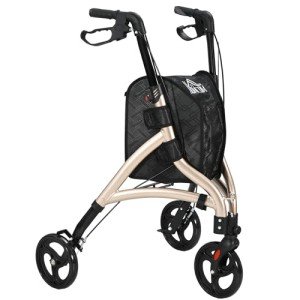
4-Wheel Walker
Overview
-
Sectors Logistics
-
Posted Jobs 0
-
Viewed 63
Company Description
11 Creative Methods To Write About Adjustable Walker
Understanding Adjustable Walkers: A Comprehensive Guide
Adjustable walkers are essential mobility aids designed to offer stability and assistance to individuals with mobility difficulties. They enhance self-reliance, safety, and confidence for people recovering from surgery, dealing with chronic conditions, or facing age-related mobility problems. This post delves into the functions, types, benefits, and typical FAQs related to adjustable walkers, using insights for possible users and caretakers.
What is an Adjustable Walker?
An adjustable Drive Medical Nitro 4-Wheel Walker in Red is a mobility aid that usually features a lightweight frame with 4 legs, geared up with handgrips for support. It can be adjusted to accommodate different heights, guaranteeing users obtain a comfortable wrist position while supporting their weight. Adjustable walkers come in different designs, each customized to specific needs.
Secret Features of Adjustable Walkers
- Height Adjustment: Most adjustable walkers have telescoping legs, allowing users to easily customize the height to fit their stature.
- Weight Capacity: Different models accommodate varying weight limits, accommodating a broad market.
- Foldability: Many walkers are collapsible, making them simple to store and transport.
- Wheels vs. No Wheels: Some walkers feature wheels on the front legs, while others have a basic design without wheels, promoting stability.
- Additional Accessories: Walkers can typically be equipped with trays, baskets, or cup holders for added benefit.
| Function | Description |
|---|---|
| Height Adjustment | Telescoping legs for customized height settings |
| Weight Capacity | Varies by design, supporting various body weights |
| Foldability | Collapsible design for easy transportation and storage |
| Wheels | Available in both wheeled and non-wheeled alternatives |
| Additional Accessories | Trays, baskets, and cup holders for user convenience |
Kinds Of Adjustable Walkers
- Requirement Walkers: Traditional models with 4 legs. Best Folding Three-Wheel Rollator Walker with Accessories for those looking for maximum stability.
- Wheeled Walkers (Rollators): Walkers with two or more wheels, enabling for easier maneuvering.
- Hemi Walkers: Designed for people with making use of one hand, including a single arm assistance for added stability.
- Child Walkers: Specifically developed for infants discovering to walk, promoting safety and assistance throughout early mobility.
Benefits of Using Adjustable Walkers
Increase Independence
- Boosted Mobility: Adjustable walkers enable users to browse their environments with more ease and self-confidence, promoting a sense of independence.
- Ease of access: Rollator With Brakes the ideal walker, users can keep their lifestyle and participate in activities they take pleasure in without help.
Injury Prevention
- Stability and Support: Four-wheel Walker users can keep much better balance and avoid falls, which are particularly important for seniors and people recuperating from surgical treatment.
- Lowered Strain: Proper use of a walker can reduce tension on joints and muscles, lessening the danger of injury during mobility.
Comfort and Customization
- Adjustable Settings: Walkers can be tailored to each user’s height and convenience, offering a more personalized experience.
- Additional Features: Options for accessories assist in accommodating individual requirements, making it possible for users to carry products while moving.
Costs and Considerations
The rate of adjustable walkers varies depending on features, products, and brand name. Here’s a summary of the typical expenses related to various types:
| Walker Type | Typical Cost |
|---|---|
| Standard Walkers | ₤ 50 – ₤ 100 |
| Wheeled Walkers | ₤ 75 – ₤ 200 |
| Hemi Walkers | ₤ 60 – ₤ 150 |
| Infant Walkers | ₤ 30 – ₤ 70 |
Regularly Asked Questions (FAQs)
1. How do I know which adjustable walker is best for me?
The ideal adjustable walker depends upon your particular needs, physical condition, and environment. It’s vital to seek advice from a health care professional to figure out the most ideal type.
2. Can I adjust the height of any walker?
A lot of adjustable walkers feature a height-adjustment mechanism. Nevertheless, not all walkers are adjustable. It’s important to examine product specifications before acquiring.
3. Are wheeled walkers safe to use?
Yes, wheeled walkers (or rollators) are safe for users who can browse them properly. They often include brakes for added safety when stationary.
4. How do I look after my adjustable walker?
Routine care includes cleaning up the walker with mild soap and water, looking for wear on grips and wheels, and ensuring systems run smoothly.

5. Can I take my adjustable walker on public transportation?
Yes, numerous adjustable walkers are foldable and created for simple transportation. Nevertheless, it’s a good idea to inspect the particular standards of the transportation service.
6. Do I need support to use an adjustable walker?
Many users can run adjustable walkers independently, specifically when appropriately fitted to their height. However, those with extreme mobility problems might take advantage of help.
Adjustable walkers are important tools for enhancing mobility, self-reliance, and safety. With a variety of design and styles, people can discover a walker tailored to their needs. Caregivers and users alike should appreciate the value of consulting healthcare experts to make educated choices concerning mobility aids. Comprehending the features, benefits, and factors to consider of adjustable walkers empowers people to preserve an active way of life, enhancing their lifestyle despite mobility challenges.
